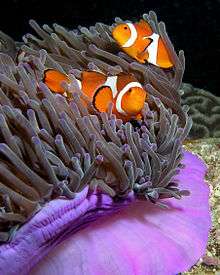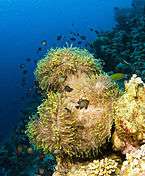Heteractis magnifica
| Heteractis magnifica | |
|---|---|
_in_Heteractis_magnifica_(Magnificent_sea_anemone).jpg) | |
| Heteractis magnifica with Amphiprion perideraion | |
| Scientific classification | |
| Kingdom: | Animalia |
| Phylum: | Cnidaria |
| Class: | Anthozoa |
| Order: | Actiniaria |
| Family: | Stichodactylidae |
| Genus: | Heteractis |
| Species: | H. magnifica |
| Binomial name | |
| Heteractis magnifica (Quoy & Gaimard, 1833) | |
| Synonyms | |
| |
The magnificent sea anemone (Heteractis magnifica), also known as the Ritteri anemone, is a species of sea anemone belonging to the Stichodactylidae family native from the Indo-Pacific area.
Description
The magnificent sea anemone is characterized by a flared oral disc which reaches between 20 and 50 centimeters in diameter but in some specimens this can reach one meter.[1] The oral disc, the base of the tentacles, and the oral orifice have the same color going from light beige to white.
The numerous tentacles are exceeding 8 centimeters long. The sea anemone, being a member of the Hexacorallia, usually carries tentacles in multiples of 6 that are positioned in concentric circles. Their tips are fingered and often lighter in coloration than the tentacle body and are sometimes vividly colored.
Its scientific and vernacular names come from the bright color of the column, which is the visible outer structure when the animal retracts, and these range from electric blue to green, red, pink, purple or brown.
Distribution & habitat
The magnificent sea anemone is widespread throughout the tropical and subtropical waters of the Indo-Pacific area from the eastern coasts of Africa, Red Sea included, to Polynesia and from south Japan to Australia and New-Caledonia[2][3]
This anemone likes hard substrates well exposed to light and current from the surface to 20 meters deep.[2] While usually found down to 20 meters deep, it has been observed down to 40 meters deep.[4]
Biology
The magnificent sea anemone has two feeding methods. The first one is through the photosynthesis of its symbiotic zooxanthellae, living in its tissues. And the second method is by capturing its prey with its tentacles that allow it to immobilize its prey (small invertebrates, fry or juvenile fish).
The reproduction of the anemone can be sexual by simultaneous transmission of male and female gametes in the water or asexual by scissiparity.[5] This means that the anemone divides itself into two separate individuals from the foot or the mouth. The magnificent sea anemone is found as solitary specimens throughout its range with aggregations only being found in the rim areas of its distribution. Genetic analyses does not suggest a difference between solitary specimens in the central distribution and clustering specimens at the rim. Asexual reproduction is found only in the rim areas and is probably the origin of the large aggregations.[4]
The relationship between anemonefish and their host sea anemones is highly nested in structure. With 12 species of hosted anemonefish, the magnificent sea anemone is highly generalist. The anemonefish it hosts are also mostly generalist, with the A. pacificus being only hosted by H magnifica. The other specialised fish is A. akallopisos which is also hosted by Stichodactyla mertensii.[6] The species of anemonefish hosted by the magnificent sea anemone are: [7]
- Amphiprion akallopisos(Skunk anemonefish)
- A. akindynos (Barrier Reef anemonefish)
- A. bicinctus (Two-band anemonefish)
- A. chrysogaster (Mauritian anemonefish)
- A. chrysopterus (Orange-fin anemonefish)
- A.clarkii (Clark's anemonefish)
- A. leucokranos (White-bonnet anemonefish)
- A. melanopus (Red & Black anemonefish)
- A. nigripes (Maldive anemonefish)
- A. ocellaris (False Clown anemonefish)
- A. pacificus (Pacific anemonefish) [8]
- A. percula (Clown anemonefish)
- A. perideraion (Pink skunk anemonefish)
H. magnifica also hosts Dascyllus trimaculatus, the threespot dascyllus, and various commensal shrimps.
Gallery
Symbionts in H. magnifica
 A. akallopisos (Skunk anemonefish)
A. akallopisos (Skunk anemonefish)- A. bicinctus (Two-band anemonefish)
 A. chrysopterus (Orange-fin anemonefish)
A. chrysopterus (Orange-fin anemonefish)_in_Heteractis_magnifica_(Magnificent_anemone).jpg) A. melanopus (Red & Black anemonefish)
A. melanopus (Red & Black anemonefish) A. nigripes (Maldive anemonefish)
A. nigripes (Maldive anemonefish) A. ocellaris (False Clown anemonefish)
A. ocellaris (False Clown anemonefish) A. perideraion (Pink skunk anemonefish)
A. perideraion (Pink skunk anemonefish) Dascyllus trimaculatus (threespot dascyllus)
Dascyllus trimaculatus (threespot dascyllus) A porcelain crab Neopetrolisthes maculatus
A porcelain crab Neopetrolisthes maculatus
References
- ↑ Weinberg S., 1996, DECOUVRIR LA MER ROUGE ET L’OCEAN INDIEN, ed. Nathan nature, France, 415p.
- 1 2 Arvedlund M.; Nielsen L.E. (1996). "Do the anemonefish Amphiprion ocellaris (Pisces : Pomacentridae) imprint themselves to their host sea anemone Heteractis magnifica (Anthozoa : Actinidae) ?". Ethology. pp. 197–211. doi:10.1111/j.1439-0310.1996.tb01118.x
- ↑ Fautin, D. 2007. Actinaria of New Caledonia. In: Payri, C. & Richer De Forges, B. [Eds]. Compendium of marine species of New Caledonia. Doc. Sci. Tech. IRD, Nouméa. II7(2): 135.
- 1 2 Drachen, T.M; Drachen Anders; Nielsen, L.E.; Chadwick, N. E. (2005). "An assemblage of the host anemone Heteractis magnifica in the northern Red Sea, and distribution of the resident anemonefish.". Journal of the Marine Biological Association of the United Kingdom. 84: 671–674. doi:10.1017/S0025315404009737h.
- ↑ Scott A., Harrison P.L., 2007, Embryonic and Larval Development of the Host Sea Anemones Entacmaea quadricolor and Heteractis crispa, Biol. Bull., 213, 110-121.
- ↑ Ollerton J; McCollin D; Fautin DG; Allen GR. (2007). "Finding NEMO: nestedness engendered by mutualistic organization in anemonefish and their hosts". Proc R Soc B Biol Sci. (274): 591–598. doi:10.1098/rspb.2006.3758.
- ↑ Fautin, Daphne G.; Allen, Gerald R. (1997). Field Guide to Anemone Fishes and Their Host Sea Anemones. Western Australian Museum. ISBN 9780730983651. Archived from the original on 14 April 2015.
- ↑ Allen, G; Drew, J; Fenner, D (2010). "Amphiprion pacificus, a new species of anemonefish (Pomacentridae) from Fiji, Tonga, Samoa, and Wallis Island". aqua, International Journal of Ichthyology. pp. 129–138. ISSN 0945-9871
External links
| Wikimedia Commons has media related to Heteractis magnifica. |
| Wikispecies has information related to: Heteractis magnifica |
- "Heteractis magnifica". Integrated Taxonomic Information System.
- Heteractis magnifica. Quoy & Gaimard, 1833. Retrieved through: World Register of Marine Species.